Whether you are installing your home theatre system, security cameras, or an internet connection, using the correct coax cable will help you experience perfect signals instead of dealing with unwanted internet connectivity problems. Coaxial cables are used in many communication networks to transmit your cable television signal all the way to high-speed internet and CCTV video footage.
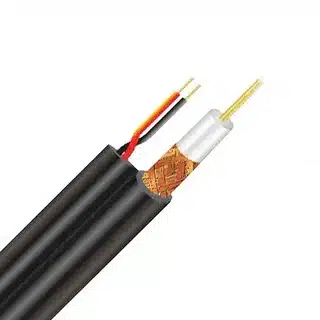
Installing a new satellite dish, upgrading your home network, or installing a security system RG6 and RG59 These are just some ways that having the knowledge about the differences between the different types of RG59 and RG6 cables will be useful. Making the wrong choice may lead to the low quality of signal, increased signal attenuation frequent dropouts, or necessity to reinstall the chosen model in the future at a high cost.
This guide will assist you in making an informed choice by unraveling the main differences, advantages, and the intended usage between both cable types, including their characteristic impedance .
Quick Comparison: RG59 vs RG6 at a Glance
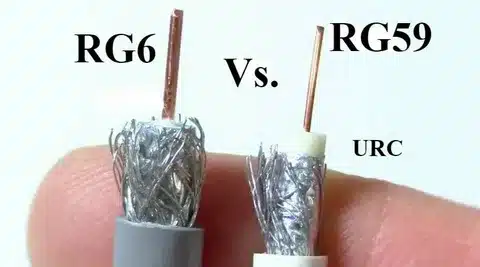
In short, the main differences are, generally, as follows:
RG59 Coaxial Cable:
- Condutor Gauge: +- 20-22 AWG (thinner)
- Thinner Insulation layer: Dielectric Insulation
- Shielding: Single braided only
- Frequency Range: Low frequencies ( <50 MHz in general)
- Signal Loss: Greater loss per 100 feet
- Common Applications: Older CCTV
RG6 Coaxial Cable:
- Gauge of Conductor: ~18 AWG (thicker)
- Dielectric Insulation: Thicker insulation to adopt better performance
- Dual Shielding: Foil + braided
- Frequency Range: High frequencies (up to GHz frequencies)
- Signal Loss: Decreases Attenuation per 100 feet
- The normal applications Satellite TV, cable broadband, HDTV and digital apps
RG6 cables come with a thicker core conductor and better shielding, and their overall diameter is larger, which is why they are applied in most new applications though RG59 can be used on certain legacy systems.
Understanding RG59 Coaxial Cable coax cable
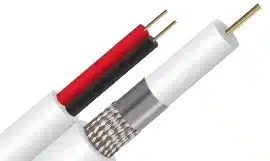
G59 coax type has a reduced dimension of the center conductor (usually 20-22 AWG) running through minimized dielectric protection and having only single layer braid shield. Because of this construction, it is more bendable and easier to operate in cramped clases which is why it was much in use in older set-ups.
The lightweight and low cost of the cable ensured its use on analogy video and simple forms of CCTV. It is more flexible, and thus can be easily routed through walls and other tight areas during installation, especially in residential homes.
Nonetheless, the construction of RG59 is also heavily limited. The thinner latter has less signal losses over distance, and less protection against electromagnetic interference. This results in making it less effective at high-frequency digital signals or longer cable runs wherein signal integrity is a consider-action, particularly over long distances.
Why RG6 Coaxial Cable Dominates Modern Applications

G6 coaxial cable is an amazing improvement both in the construction and performance. RG6 also has a larger 18 AWG center conductor, thicker dielectric insulation, and a dual shielding which contributes to its low signal loss. that provides better signal quality to be used in demanding applications.
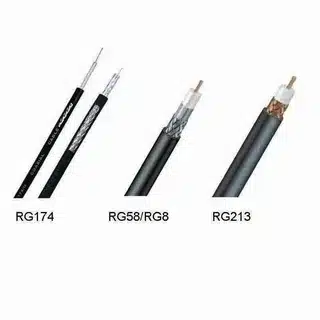
The combination of a braided copper shield with an aluminum foil one is usually used to provide a powerful shield against the effects of nearby sources of electrical and electromagnetic interference, as well as cell phones, and other sources of electromagnetic noise. Even some high end RG6 cables can be asymmetrically shielded as quad-shielded to provide maximum resistance to external noise sources
antennas.
This strong build allows RG6 to channel high-frequency signals successfully, making it ideal for high frequency applications such as satellite TV, cable internet, and High-Definition TV broadcasting among other digital uses more signal loss. This lower signal attenuation will allow to run longer, solid cables with no noticeable decline in signal levels, making it an excellent means of use through whole-home installation.
Special types of G6 cables include plenum-rated cables, used in commercial premises and where the cable rises through ductwork; outdoor versions, where the cable requires protection against UV degradation; and direct-burial, where the cable must be protected against moisture (either by water blocking within the compound, or more often, by encapsulating the cable in a water-proof material) smaller diameter.
Critical Factors That Impact Your Cable Choice
When choosing between RG59 and RG6, it is important to consider the manufacturer as well, along with a few technical considerations that should further guide your choice other than the mere specifications.
Signal loss is more frequency-dependent and distance-dependent, and the excellent performance of RG6 becomes more and more important at longer distances or higher frequencies google search. Both cables normally have the 75-ohm and they are appropriate in situations that require both the transmission of video and audio applications, but on RG6, its impedance is held more effectively over a broad range right cable.
Environment also contributes to this too Installation at outdoor and underground locations or commercial buildings that demand strict fire rating requirements of cables are to be used as well. G6 provides more alternatives in this respect, including its specialized versions which are allowed to work in extreme environments radio communications.
Another factor which should be looked into is compatibility with connectors RG6 is heavier and may need other connector solutions or installation methods that a RG59 may not need cctv systems. This is one consideration to make with regard to planning and budget.
Making the Right Choice for Your Application rg 58
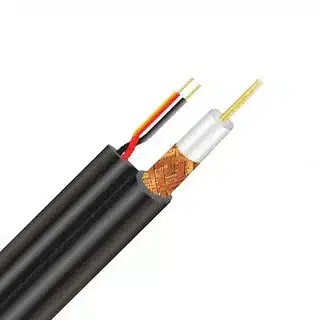
Here’s a clear table comparing RG58, RG59, and RG6 based on your notes:
| Feature / Factor | RG58 | RG59 | RG6 |
|---|---|---|---|
| Typical Use | Older analog CCTV, short-distance low-frequency applications | Analog video, short runs, temporary setups | Digital applications: satellite TV, cable internet, HD TV, IP cameras |
| Signal Quality | Moderate | Good for short runs, not ideal for high-frequency signals | Excellent; low attenuation, superior shielding |
| Flexibility / Installation | Flexible, easy to install | Highly flexible, good for temporary or tight spaces | Less flexible, thicker cable |
| Length Suitability | Short runs | Short runs | Long runs; can maintain signal over distance |
| Noise Resistance | Moderate | Moderate | High; ideal for electrically noisy environments |
| Cost | Low | Low to moderate | Higher; more expensive but future-proof |
| Future Upgrades / Compatibility | Limited | Limited; fewer upgrade possibilities | High; supports advanced digital systems and broadband internet |
| Best Choice For | Low-cost, simple analog setups | Temporary analog setups or CCTV with low signal needs | Long-term installations, high-performance digital or broadband systems |
Use RG59 with analog video when piloting analog video systems, depending on older CCTV that does not need high-frequency operation cable depends. It is cheaper and flexible, thus it can be well used in short runs where the quality signal requirement is not so sensitive cable tv.
G59 is also good in temporary set ups or installations where flexibility is a requirement during the installation. But think as such that by buying RG59 now, you will have fewer upgrade possibilities in the future.
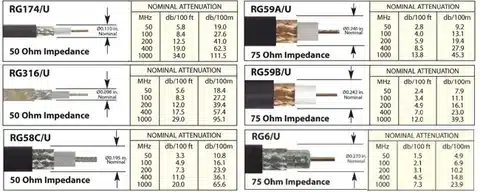
RG6 can be used in any digital application, including satellite television, cable internet, high-definition television distribution, and various different applications, as well as in amateur radio setup signal boosting. , or advanced model IP camera systems to effectively transmit signals . Because it has a superior shielding and lower attenuation levels, it is absolutely necessary in the long cable runs or in the places where electrically noisy conditions exist.
G6 is most interesting in the case of broadband internet connectivity where signal quality and consequent connection speed and reliability, is of relevance rg 58. The money you spend on RG6 wire is well worth the investment in electronics as regards performance and future-proofing your installation.
Common Questions About Coaxial Cable Selection
What does “RG” actually mean? The current “RG” designation is derived originally as radio guide, a type of military specification developed during World War II. The cable industry still uses this cable system numbering which standards are called RG numbers.
Can I replace RG59 with RG6 in existing installations? Usually, but remember that the diameter of RG6 is thicker which may mean that holes have to be larger, or routing routes are changed. It will require connectors of larger size to suit RG6 diameter connectors.
Is quad-shielded RG6 worth the extra cost? In hi-interference areas or where critical applications are desired, quad-shielded RG6 is used. The additional expense is normally well worth it where the installer is a professional or where there is substantial electronic interference in the home.
What about other cable types like RG11 or RG58? Area SG11 employs a still thicker conductor on very long runs but is even more cost prohibitive to body. G58 is a 50-ohm cable that is once again applied in data and radio applications and is not interchangeable with video systems.
Conclusion: Future-Proof Your Installation
In modern applications, RG6 coaxial cable has come out as the best choice, especially when used with measurement equipment . Its better construction, durability, minimized signal loss, and shielding come into play to be the reasonable option in satellite television, cable internet., high definition television distribution, and security camera system. Although it is priced a little bit higher than RG59, it is worth the price since it offers better performances and has a longer lifespan.
The current implementation of G59 continues to be used in analog video systems and in other circumstances where the greatest compatibility is needed although in most applications its limitations preclude its use.
Take into consideration your own needs: What frequencies will you be transmitting? What is average length of the cable runs? What is the electrical ambiance? Responses to these questions will enable you to find the appropriate cable to use in order to transmit a high-quality signal reliably.
The proper selection of a coaxial cable will not only save you time, money and frustration in the long run but make the upgrade of your established system or new installation.
